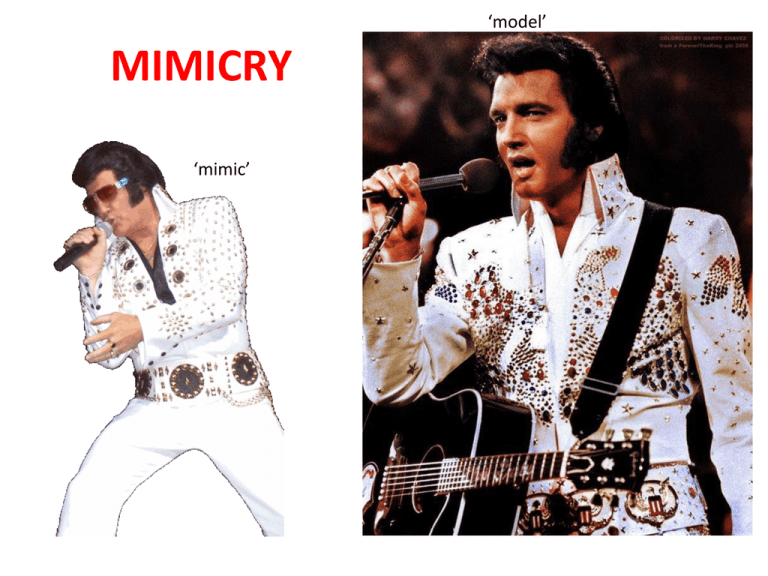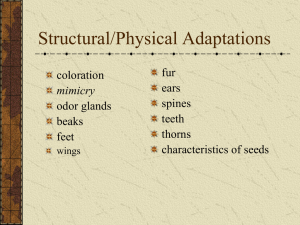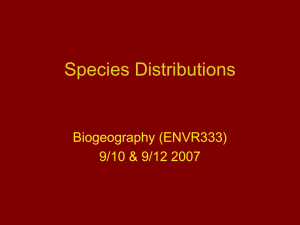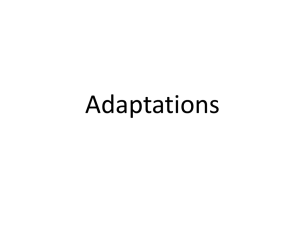
‘model’
MIMICRY
‘mimic’
‘mimicry complex’
‘diffuse mimicry’
Crypsis: - crypsis is the ability of an organism to avoid observation or detection by
other organisms. It may be either a predation strategy or an antipredator adaptation, and
methods include camouflage, nocturnality, subterranean lifestyle, transparency,[2] and
mimicry (Wikipedia).
Crypsis: - crypsis is the ability of an organism to avoid observation or detection by
other organisms. It may be either a predation strategy or an antipredator adaptation, and
methods include camouflage, nocturnality, subterranean lifestyle, transparency,[2] and
mimicry (Wikipedia).
Mimicry: mimicry is the similarity of one species to another.
[2]
This similarity can
be in appearance, behaviour, sound, scent and even location, with the mimics found in
similar places to their models. (Wikipedia)
Coral Snake - venomous
Milk Snake – non-venomous
Can get complicated….
Alligator snapper looks like a rock (crypsis), but has a tongue
that ‘mimics’ a small fish
video
Frogfish
video
Mimicry for predator avoidance:
Batesian: a palatable mimic looks like an unpalatable model, and so gains protection
Three different,
unpalatable
species
Mimicry for predator avoidance:
Batesian: a palatable mimic looks like an unpalatable model, and so gains protection
Three different,
unpalatable
species
Three female
morphs of a single
palatable species;
each mimics an
unpalatable species
in its range.
Mimicry for predator avoidance:
Batesian: a palatable mimic looks like an unpalatable model, and so gains protection
Non-mimetic morphs
of the same species,
Papilio dardanus
(African Swallowtail)
Three different,
unpalatable
species
Three female
morphs of a single
palatable species;
each mimics an
unpalatable species
in its range.
Mimicry for predator avoidance:
Batesian: a palatable mimic looks like an unpalatable model, and so gains protection
Honey bee
Stingless flies, moths, and beetles
Mimicry for predator avoidance:
Batesian: a palatable mimic looks like an unpalatable model, and so gains protection
This is a katydid, NOT an ant…
Mimicry for predator avoidance:
Batesian: a palatable mimic looks like an unpalatable model, and so gains protection
Snake-head caterpillars (different species)
Mimicry for predator avoidance:
Batesian: a palatable mimic looks like an unpalatable model, and so gains protection
Automimicry?
Mimicry for predator avoidance:
Batesian: a palatable mimic looks like an unpalatable model, and so gains protection
Spider
Ants are unpalatable to most birds and are avoided,
selecting for mimicry in many other insects
Fly
Hemipteran (bug)
Hemipteran
Beetle
Mimicry for predator avoidance:
Batesian: a palatable mimic looks like an unpalatable model, and so gains protection
Mullerian: unpalatable species converge on a common morphology – mimicking one
another, in a sense.
Monarch
Viceroy
Mimicry for predator avoidance:
Batesian: a palatable mimic looks like an unpalatable model, and so gains protection
Mullerian: unpalatable species converge on a common morphology – mimicking one
another, in a sense.
Four species of distasteful butterflies
in the Amazon – mimicry complex
Mimicry for predator avoidance:
Batesian: a palatable mimic looks like an unpalatable model, and so gains protection
Mullerian: unpalatable species converge on a common morphology – mimicking one
another, in a sense.
Mimicry for predator avoidance:
Emslyan: deadly species may not always serve as models, because they give predators little
chance to learn to avoid them. Coral snakes, for instance, are deadly. But false coral snakes
are mildly poisonous (not deadly). So, it MAY be that coral snakes and milk snakes are
mimicking false coral snakes.
FALSE
MILK
CORAL
Mimicry/Crypsis by predators to GET a meal:
Mimicry/Crypsis by predators to GET a meal:
Mimicry/Crypsis by predators to GET a meal:
Mimicry/Crypsis by predators to GET a meal:
Mimicry/Crypsis by predators to GET a meal:
Female Photuris versicolor mimic the light pattern of
other species and eat males that come in response.
Male P. versicolor mimic other species, too, to get close
enough to their own females to attempt mating
Ant-mimic spiders
video
Selection favoring particular plant
morphologies
Artificial Selection favoring particular
plant morphologies in “weeds”
Wheat
Rye – secondary crop
Artificial Selection favoring particular
plant morphologies in “weeds”
Rice
Echinochloa oryzoides
Chemical Mimicry
Bola spiders and bird-dropping
spiders:
– emit pheromone that mimics
the sex pheromone of certain
moth species… male moths
come and get eaten.
Chemical Mimicry
Some orchids emit the sex
pheromone of a particular wasp
species. Males come and “mate”
with the flower, getting dusted
with pollen.
video
Chemical Mimicry
Orchid emits pheromones that
mimic aphid alarm phermones.
This attracts hover flies that eat
aphids… and they end up
transferring pollen between
flowers.
Chemical Mimicry
Blister beetle – Meloe franciscanus
Larvae emit the sex pheromone of the
solitary bee, Habropoda pallida.
Male bees come to a larval mass to
mate, and get covered with larvae.
They transfer these to females when
they DO mate, and then larvae are
taken to the nest where they eat bee
eggs and larvae.
video
Predators
Mutualists
Selective
Pressures
Morphology
Behavior
Chemistry
Prey
Parasites
Response
Mimicry of env (crypsis), predators, or prey to
maximize survival, feeding efficiency (growth), or
reproduction









